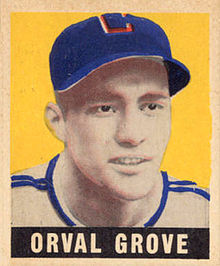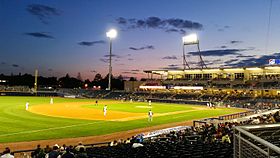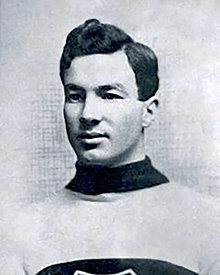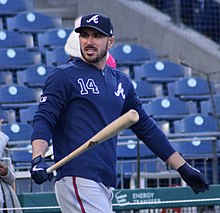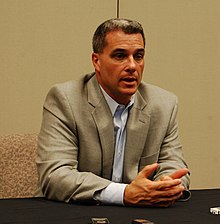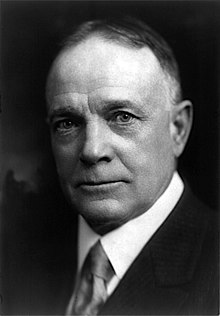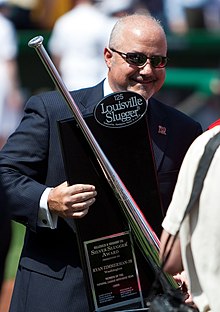Portal:Baseball
Portal maintenance status: (June 2018)
|
| Main page | Content, Categories & Topics | WikiProjects & Things you can do |
The Baseball Portal
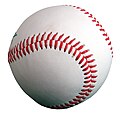
Baseball is a bat-and-ball sport played between two teams of nine players each, taking turns batting and fielding. The game occurs over the course of several plays, with each play generally beginning when a player on the fielding team, called the pitcher, throws a ball that a player on the batting team, called the batter, tries to hit with a bat. The objective of the offensive team (batting team) is to hit the ball into the field of play, away from the other team's players, allowing its players to run the bases, having them advance counter-clockwise around four bases to score what are called "runs". The objective of the defensive team (referred to as the fielding team) is to prevent batters from becoming runners, and to prevent runners' advance around the bases. A run is scored when a runner legally advances around the bases in order and touches home plate (the place where the player started as a batter).
The opposing teams switch back and forth between batting and fielding; the batting team's turn to bat is over once the fielding team records three outs. One turn batting for each team constitutes an inning. A game is usually composed of nine innings, and the team with the greater number of runs at the end of the game wins. Most games end after the ninth inning, but if scores are tied at that point, extra innings are usually played. Baseball has no game clock, though some competitions feature pace-of-play regulations such as the pitch clock to shorten game time.
Baseball evolved from older bat-and-ball games already being played in England by the mid-18th century. This game was brought by immigrants to North America, where the modern version developed. Baseball's American origins, as well as its reputation as a source of escapism during troubled points in American history such as the American Civil War and the Great Depression, have led the sport to receive the moniker of "America's Pastime"; since the late 19th century, it has been unofficially recognized as the national sport of the United States, though in modern times is considered less popular than other sports, such as American football. In addition to North America, baseball spread throughout the rest of the Americas and the Asia–Pacific in the 19th and 20th centuries, and is now considered the most popular sport in parts of Central and South America, the Caribbean, and East Asia, particularly in Japan, South Korea, and Taiwan. (Full article...)
 Featured articles - load new batch
Featured articles - load new batch
-
Image 1
Orval Leroy Grove (August 29, 1919 – April 20, 1992) was an American professional baseball pitcher in Major League Baseball who played for ten seasons in the American League with the Chicago White Sox. In 207 career games, Grove pitched 1,176 innings and posted a win–loss record of 63–73, with 66 complete games, 11 shutouts, and a 3.78 earned run average (ERA).
The only freshman on the Proviso Township High School varsity baseball team, Grove's pitching ability attracted the attention of the White Sox. After signing with the team in 1937, Grove moved between the major leagues and minor leagues for a few seasons until 1943, when he found a solid place in the White Sox's pitching rotation. Grove had a career-year in 1943, finishing the season with career-bests in ERA, wins, and complete games; in 1944, he made his only All-Star appearance. (Full article...) -
Image 2Advertisement in Billboard magazine in 1907
How Brown Saw the Baseball Game is an American short silent comedy film produced in 1907 and distributed by the Lubin Manufacturing Company. The film follows a baseball fan named Mr. Brown who overdrinks before a baseball game and becomes so intoxicated that the game appears to him in reverse motion. During production, trick photography was used to achieve this effect. The film was released in November 1907. It received a positive review in a 1908 issue of The Courier-Journal that reported the film was successful and "truly funny". As of 2021[update], it is unclear whether the print of the film has survived. The identities of the film cast and production crew are unknown. Film historians have noted similarities between the plot of How Brown Saw the Baseball Game and How the Office Boy Saw the Ball Game. It is a comedy film directed by Edwin S. Porter, having released a year before How Brown Saw the Baseball Game. (Full article...) -
Image 3The 2009 World Series was the championship series of Major League Baseball's (MLB) 2009 season. As the 105th edition of the World Series, it was a best-of-seven playoff contested between the Philadelphia Phillies, champions of the National League (NL) and defending World Series champions, and the New York Yankees, champions of the American League (AL). The Yankees defeated the Phillies, 4 games to 2, winning their 27th World Series championship.
The series was played between October 28 and November 4, broadcast on Fox, and watched by an average of roughly 19 million viewers. Home field advantage for the Series went to the AL for the eighth straight year as a result of its 4–3 win in the All-Star Game. The Phillies earned their berth into the playoffs by winning the National League East. The Yankees won the American League East to earn their berth, posting the best record in the Major Leagues. The Phillies reached the World Series by defeating the Colorado Rockies in the best-of-five National League Division Series and the Los Angeles Dodgers in the best-of-seven NL Championship Series (NLCS). The Yankees defeated the Minnesota Twins in the American League Division Series and the Los Angeles Angels of Anaheim in the AL Championship Series (ALCS) to advance to their first World Series since 2003. As a result of their loss, the Phillies became the first team since the 2001 Yankees to lose the World Series after winning it the previous year. As of 2024, this is the most recent World Series to feature a defending champion. (Full article...) -
Image 4
James Francis Thorpe (Meskwaki: Wa-Tho-Huk, translated as "Bright Path"; May 22 or 28, 1887 – March 28, 1953) was an American athlete and Olympic gold medalist. A member of the Sac and Fox Nation, Thorpe was the first Native American to win a gold medal for the United States in the Olympics. Considered one of the most versatile athletes of modern sports, he won two Olympic gold medals in the 1912 Summer Olympics (one in classic pentathlon and the other in decathlon). He also played football (collegiate and professional), professional baseball, and professional basketball.
He lost his Olympic titles after it was found he had been paid for playing two seasons of semi-professional baseball before competing in the Olympics, thus violating the contemporary amateurism rules. In 1983, 30 years after his death, the International Olympic Committee (IOC) restored his Olympic medals with replicas, after ruling that the decision to strip him of his medals fell outside of the required 30 days. Official IOC records still listed Thorpe as co-champion in decathlon and pentathlon until 2022, when it was decided to restore him as the sole champion in both events. (Full article...) -
Image 5

WSNS-TV (channel 44) is a television station in Chicago, Illinois, United States, serving as the local outlet for the Spanish-language network Telemundo. It is owned and operated by NBCUniversal's Telemundo Station Group alongside NBC outlet WMAQ-TV (channel 5). The two stations share studios at the NBC Tower on North Columbus Drive in the city's Streeterville neighborhood and broadcast from the same transmitter atop the Willis Tower in the Chicago Loop.
WSNS-TV began broadcasting in 1970. Originally specializing in the automated display of news headlines, it evolved into Chicago's third full-fledged independent station, carrying movies, local sports, and other specialty programming. This continued until 1980, when WSNS became the Chicago-area station for ON TV, an over-the-air subscription television (STV) service owned by Oak Industries, which took a minority ownership stake in the station. While ON TV was successful in Chicago and the subscription system became the second-largest in the country by total subscribers, the rise of cable television precipitated the end of the business in 1985, with WSNS-TV as the last ON TV station standing. (Full article...) -
Image 6Disco Demolition Night was a Major League Baseball (MLB) promotion on Thursday, July 12, 1979, at Comiskey Park in Chicago, Illinois, that ended in a riot. At the climax of the event, a crate filled with disco records was blown up on the field between games of the twi-night doubleheader between the Chicago White Sox and the Detroit Tigers. Many had come to see the explosion rather than the games and rushed onto the field after the detonation. The playing field was so damaged by the explosion and by the rioters that the White Sox were required to forfeit the second game to the Tigers.
In the late 1970s, dance-oriented disco was the most popular music genre in the United States, particularly after being featured in hit films such as Saturday Night Fever (1977). However, disco sparked a major backlash from rock music fans—an opposition prominent enough that the White Sox, seeking to fill seats at Comiskey Park during a lackluster season, engaged Chicago shock jock and anti-disco campaigner Steve Dahl for the promotion at the July 12 doubleheader. Dahl's sponsoring radio station was WLUP (97.9 FM, now WCKL), so admission was discounted to 98 cents for attendees who turned in a disco record; between games, Dahl was to destroy the collected vinyl in an explosion. (Full article...) -
Image 7
First Horizon Park, formerly known as First Tennessee Park, is a baseball park in downtown Nashville, Tennessee, United States. The home of the Triple-A Nashville Sounds of the International League, it opened on April 17, 2015, and can seat up to 10,000 people. It replaced the Sounds' former home, Herschel Greer Stadium, where the team played from its founding in 1978 through 2014.
The park was built on the site of the former Sulphur Dell, a minor league ballpark in use from 1885 to 1963. It is located between Third and Fifth Avenues on the east and west (home plate, the pitcher's mound, and second base are directly in line with Fourth Avenue to the stadium's north and south) and between Junior Gilliam Way and Harrison Street on the north and south. The Nashville skyline can be seen from the stadium to the south. (Full article...) -
Image 8
James Howard Thome (/ˈtoʊmi/; TOH-mee; born August 27, 1970) is an American former professional baseball first baseman, third baseman and designated hitter, who played in Major League Baseball (MLB) for 22 seasons (1991–2012). A prolific power hitter, Thome hit 612 home runs during his career—the eighth-most all time. He amassed a total of 2,328 hits and 1,699 runs batted in (RBIs). His career batting average was .276. He was a member of five All-Star teams and won a Silver Slugger Award in 1996.
Thome grew up in Peoria, Illinois, as part of a large blue-collar family of athletes, who predominantly played baseball and basketball. After attending Illinois Central College, he was drafted by the Indians in the 1989 draft, and made his big league debut in 1991. Early in his career, Thome played third base, before eventually becoming a first baseman. With the Indians, he was part of a core of players that led the franchise to five consecutive playoff appearances in the 1990s, including World Series appearances in 1995 and 1997. Thome spent over a decade with Cleveland, before leaving via free agency after the 2002 season, to join the Philadelphia Phillies, with whom he spent the following three seasons. Traded to the Chicago White Sox before the 2006 season, he won the American League (AL) Comeback Player of the Year Award that year and joined the 500 home run club during his three-season tenure with the White Sox. By this point in his career, back pain limited Thome to being a designated hitter. After stints with the Los Angeles Dodgers and Minnesota Twins, he made brief returns to Cleveland and Philadelphia, before ending his career with the Baltimore Orioles. Upon retiring, Thome accepted an executive position with the White Sox. (Full article...) -
Image 9
Stanley Frank Musial (/ˈmjuːziəl, -ʒəl/; born Stanislaw Franciszek Musial; November 21, 1920 – January 19, 2013), nicknamed "Stan the Man", was an American baseball outfielder and first baseman. Widely considered to be one of the greatest and most consistent hitters in baseball history, Musial spent 22 seasons in Major League Baseball (MLB), playing for the St. Louis Cardinals, from 1941 to 1944 and from 1946 to 1963. He was inducted into the Baseball Hall of Fame in 1969 in his first year of eligibility.
Musial was born in Donora, Pennsylvania, where he frequently played baseball informally or in organized settings, and eventually played on the baseball team at Donora High School. Signed to a professional contract by the St. Louis Cardinals as a pitcher in 1938, Musial was converted into an outfielder and made his major league debut in 1941. Noted for his unique batting stance, he quickly established himself as a consistent and productive hitter. In his first full season, 1942, the Cardinals won the World Series. The following year, he led the NL in six different offensive categories and earned his first MVP award. He was also named to the NL All-Star squad for the first time; he appeared in every All-Star game in every subsequent season he played. Musial won his second World Series championship in 1944, then missed the 1945 season while serving in the Navy. After completing his military service, Musial returned to baseball in 1946 and resumed his consistent hitting. That year he earned his second MVP award and third World Series title. His third MVP award came in 1948, when he finished one home run short of winning baseball's Triple Crown. After struggling offensively in 1959, Musial used a personal trainer to help maintain his productivity until he decided to retire in 1963. (Full article...) -
Image 10

Cobb in 1913
During the 1912 baseball season, center fielder Ty Cobb of the Detroit Tigers was suspended for ten days after entering the spectator stands at New York's Hilltop Park during a game and physically assaulting Claude Lucker, a heckler. At the time, Cobb was among the biggest stars in the major leagues. American League president Ban Johnson suspended Cobb and fined him $50 ($1,600 in 2023).
Cobb had been Lucker's verbal target throughout the four-game series between the Tigers and New York Yankees. Facing a continued stream of insults and questioning about his racial ancestry, Cobb lost his temper in the fourth inning of the fourth game, on May 15, 1912. He raced into the stands, punching and kicking Lucker; Lucker had lost eight fingers in an industrial accident and could not defend himself. Cobb was ejected from the game. Johnson witnessed these events and suspended Cobb indefinitely. Since there were few protections for ballplayers at the time from insults and objects hurled by fans, many took Cobb's side, including his teammates. After defeating the Philadelphia Athletics on May 17, the Detroit players telegraphed Johnson that they would not play again until Cobb was reinstated; Johnson refused to do so. (Full article...) -
Image 11
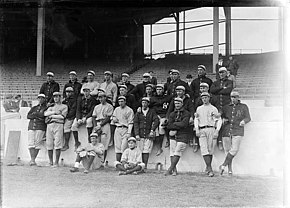
The 1913 squad, the first that went by the name "Yankees"
The history of the New York Yankees Major League Baseball (MLB) team spans more than a century. Frank J. Farrell and William Stephen Devery bought the rights to an American League (AL) club in New York City after the 1902 season. The team, which became known as the Yankees in 1913, rarely contended for the AL championship before the acquisition of outfielder Babe Ruth after the 1919 season. With Ruth in the lineup, the Yankees won their first AL title in 1921, followed by their first World Series championship in 1923. Ruth and first baseman Lou Gehrig were part of the team's Murderers' Row lineup, which led the Yankees to a then-AL record 110 wins and a Series championship in 1927 under Miller Huggins. They repeated as World Series winners in 1928, and their next title came under manager Joe McCarthy in 1932.
The Yankees won the World Series every year from 1936 to 1939 with a team that featured Gehrig and outfielder Joe DiMaggio, who recorded a record hitting streak during New York's 1941 championship season. New York set a major league record by winning five consecutive championships from 1949 to 1953, and appeared in the World Series nine times from 1955 to 1964. Mickey Mantle, Yogi Berra, and Whitey Ford were among the players fielded by the Yankees during the era. After the 1964 season, a lack of effective replacements for aging players caused the franchise to decline on the field, and the team became a money-loser for owners CBS while playing in an aging stadium. (Full article...) -
Image 12The Nashville Sounds Minor League Baseball team was established in Nashville, Tennessee, in 1978, after Larry Schmittou and a group of investors purchased the rights to operate an expansion franchise of the Double-A Southern League. The Sounds played their home games at Herschel Greer Stadium from its opening in 1978 until the end of the 2014 season. In 2015, the Sounds left Greer for First Tennessee Park, now known as First Horizon Park, a new facility located on the site of the historic Sulphur Dell ballpark, home to Nashville's minor league teams from 1885 to 1963.
The Sounds led all of Minor League Baseball in attendance in their inaugural season and continued to draw the Southern League's largest crowds in each of their seven years as members of the league. On the field, the team won six consecutive second-half division titles from 1979 to 1984 and won the Southern League championship twice: in 1979 as the Double-A affiliate of the Cincinnati Reds and again in 1982 as the Double-A affiliate of the New York Yankees. (Full article...) -
Image 13
Osborne Earl Smith (born December 26, 1954) is an American former professional baseball player. Nicknamed "The Wizard of Oz", Smith played shortstop for the San Diego Padres and St. Louis Cardinals in Major League Baseball, winning the National League Gold Glove Award for defensive play at shortstop for 13 consecutive seasons. A 15-time All-Star, Smith accumulated 2,460 hits and 580 stolen bases during his career, and won the National League Silver Slugger Award as the best hitter at shortstop in 1987. He was elected to the Baseball Hall of Fame in his first year of eligibility in 2002. He was also elected to the St. Louis Cardinals Hall of Fame in the inaugural class of 2014.
Smith was born in Mobile, Alabama; his family moved to Watts, Los Angeles, when he was six years old. While participating in childhood athletic activities, Smith possessed quick reflexes; he went on to play baseball at Locke High School in Los Angeles, then at California Polytechnic State University, San Luis Obispo. Drafted as an amateur player by the Padres, Smith made his major league debut in 1978. He quickly established himself as an outstanding fielder, and later became known for performing backflips on special occasions while taking his position at the beginning of a game. Smith won his first Gold Glove Award in 1980 and made his first All-Star Game appearance in 1981. (Full article...) -
Image 14
Robert William Meusel (July 19, 1896 – November 28, 1977) was an American baseball left and right fielder who played in Major League Baseball (MLB) for eleven seasons from 1920 through 1930, all but the last for the New York Yankees. He was best known as a member of the Yankees' championship teams of the 1920s, nicknamed "Murderers' Row", during which time the team won its first six American League (AL) pennants and first three World Series titles.
Meusel, noted for his strong outfield throwing arm, batted fifth behind Baseball Hall of Famers Babe Ruth and Lou Gehrig. In 1925, he became the second Yankee, after Ruth, to lead the AL in home runs (33), runs batted in (138) and extra base hits (79). Nicknamed "Long Bob" because of his 6-foot, 3 inch (1.91 m) stature, Meusel batted .313 or better in seven of his first eight seasons, finishing with a .309 career average; his 1,009 RBI during the 1920s were the fourth most by any major leaguer, and trailed only Harry Heilmann's total of 1,131 among AL right-handed hitters. Meusel ended his career in 1930 with the Cincinnati Reds. He hit for the cycle three times, and was the second of six major leaguers to accomplish this feat as many as three times during a career. (Full article...) -
Image 15Ross with the Montreal Wanderers, circa 1907–18
Arthur Howey Ross (January 13, 1885 – August 5, 1964) was a Canadian professional ice hockey player and executive from 1905 until 1954. Regarded as one of the best defenders of his era by his peers, he was one of the first to skate with the puck up the ice rather than pass it to a forward. He was on Stanley Cup championship teams twice in a playing career that lasted thirteen seasons; in January 1907 with the Kenora Thistles and 1908 with the Montreal Wanderers. Like other players of the time, Ross played for several different teams and leagues, and is noted for his time with the Wanderers while they were members of the National Hockey Association (NHA) and its successor, the National Hockey League (NHL). In 1911, he led one of the first organized player strikes over increased pay. When the Wanderers' home arena burned down in January 1918, the team ceased operations and Ross retired as a player.
After several years as an on-ice official, he was named head coach of the Hamilton Tigers for one season. When the Boston Bruins were formed in 1924, Ross was hired as the first coach and general manager of the team. He later coached the team on three separate occasions until 1945, and stayed as general manager until his retirement in 1954. Ross helped the Bruins finish first place in the league ten times and win the Stanley Cup three times; Ross personally coached the team to two of those victories. After being hired by the Bruins, Ross, along with his wife and two sons, moved to a suburb of Boston, and he became an American citizen in 1938. He died near Boston in 1964. (Full article...)
General images - load new batch
-
Image 1A well-worn baseball (from Baseball)
-
Image 3A New York Yankees batter (Andruw Jones) and a Boston Red Sox catcher at Fenway Park (from Baseball)
-
Image 4A runner sliding into home plate and scoring. (from Baseball)
-
Image 5Japanese-Americans spectating a World War II-era game while in an internment camp. America's ties to immigrants and to Japan have been deeply shaped by a shared baseball heritage. (from History of baseball)
-
Image 6Sadaharu Oh managing the Japan national team in the 2006 World Baseball Classic. Playing for the Central League's Yomiuri Giants (1959–80), Oh set the professional world record for home runs. (from Baseball)
-
Image 8The typical motion of a right-handed pitcher (from Baseball rules)
-
Image 9The NL champion New York Giants baseball team, 1913. Fred Merkle, sixth in line, had committed a baserunning gaffe in a crucial 1908 game that became famous as Merkle's Boner. (from History of baseball)
-
Image 10Sadaharu Oh managing the Japan national team in the 2006 World Baseball Classic. Playing for the Central League's Yomiuri Giants (1959–80), Oh set the professional world record for home runs with 868. (from History of baseball)
-
Image 11Fenway Park, home of the Boston Red Sox. The Green Monster is visible beyond the playing field on the left. (from Baseball)
-
Image 12A first baseman receives a pickoff throw, as the runner dives back to first base. (from Baseball)
-
Image 16Diagram of a baseball field Diamond may refer to the square area defined by the four bases or to the entire playing field. The dimensions given are for professional and professional-style games. Children often play on smaller fields. (from Baseball)
-
Image 172013 World Baseball Classic championship match between the Dominican Republic and Puerto Rico, March 20, 2013 (from Baseball)
-
Image 18A pitcher handing off the ball after being taken out of the game during a mound meeting. (from Baseball)
-
Image 20Jackie Robinson in 1945, with the era's Kansas City Royals, a barnstorming squad associated with the Negro American League's Kansas City Monarchs (from Baseball)
-
Image 21Pitchers are generally substituted during mound visits (team gatherings at the pitcher's mound). (from Baseball rules)
-
Image 22The strike zone, which determines the outcome of most pitches, varies in vertical length depending on the batter's typical height while swinging. (from Baseball rules)
-
Image 23An Afghan girl playing baseball in August 2002 (from Baseball)
-
Image 25Cover of Official Base Ball Rules, 1921 edition, used by the American League and National League (from Baseball rules)
-
Image 26Pick-off attempt on runner (in red) at first base (from Baseball rules)
-
Image 27Alexander Cartwright, father of modern baseball (from History of baseball)
-
Image 28In May 2010, the Philadelphia Phillies' Roy Halladay pitched the 20th major league perfect game. That October, he pitched only the second no-hitter in MLB postseason history. (from History of baseball)
-
Image 29A game from the Cantigas de Santa Maria, c. 1280, involving tossing a ball, hitting it with a stick and competing with others to catch it (from History of baseball)
-
Image 30Baserunners generally stand a short distance away from their base between pitches, preparing themselves to either go back or steal the next base. (from Baseball rules)
-
Image 31By the 1860s Civil War, baseball (bottom) had overtaken its fellow bat-and-ball sport cricket (top) in popularity within the United States. (from History of baseball)
-
Image 32Jackie Robinson in 1945, with the era's Kansas City Royals, a barnstorming squad associated with the Negro American League's Kansas City Monarchs (from History of baseball)
-
Image 34Pesäpallo, a Finnish variation of baseball, was invented by Lauri "Tahko" Pihkala in the 1920s, and after that, it has changed with the times and grown in popularity. Picture of Pesäpallo match in 1958 in Jyväskylä, Finland. (from Baseball)
-
Image 35Baseball games sometimes end in a walk-off home run, with the batting team usually gathering at home plate to celebrate the scoring of the winning run(s). (from Baseball rules)
-
Image 36A batter follows through after swinging at a pitched ball. (from Baseball rules)
-
Image 37Rickey Henderson—the major leagues' all-time leader in runs and stolen bases—stealing third base in a 1988 game (from Baseball)
-
Image 38Two players on the baseball team of Tokyo, Japan's Waseda University in 1921 (from Baseball)
-
Image 39The strike zone determines the result of most pitches, and varies in vertical length for each batter. (from Baseball)
-
Image 40Defensive positions on a baseball field, with abbreviations and scorekeeper's position numbers (not uniform numbers) (from Baseball)
-
Image 41The standard fielding positions (from Baseball rules)
-
Image 421906 World Series, infielders playing "in" for the expected bunt and the possible play at the plate with the bases loaded (from Baseball rules)
-
Image 43Cy Young—the holder of many major league career marks, including wins and innings pitched, as well as losses—in 1908. MLB's annual awards for the best pitcher in each league are named for Young. (from Baseball)
-
Image 45The American Tobacco Company's line of baseball cards featured shortstop Honus Wagner of the Pittsburgh Pirates from 1909 to 1911. In 2007, the card shown here sold for $2.8 million. (from Baseball)
 Good articles - load new batch
Good articles - load new batch
-
Image 1Heyward with the Chicago Cubs in 2016
Jason Alias Heyward (born August 9, 1989), nicknamed "J-Hey", is an American professional baseball outfielder who is a free agent. He has played in Major League Baseball (MLB) for the Atlanta Braves, St. Louis Cardinals, Chicago Cubs, Los Angeles Dodgers and Houston Astros.
Originally the Braves' first-round selection in the 2007 MLB draft from Henry County High School in Georgia, Heyward began his minor league career at age 17. He appeared in three minor league all-star games and won two minor league player of the year awards. In 2010, multiple media outlets named Heyward the top prospect in all of baseball. (Full article...) -
Image 2
Curtis Granderson Jr. (born March 16, 1981), nicknamed "the Grandyman", is an American former professional baseball outfielder. He played 16 seasons in Major League Baseball (MLB) for the Detroit Tigers, New York Yankees, New York Mets, Los Angeles Dodgers, Toronto Blue Jays, Milwaukee Brewers, and Miami Marlins.
Granderson played college baseball at the University of Illinois at Chicago. He was selected by the Tigers in the 2002 MLB draft. He made his MLB debut with the Tigers in 2004. Granderson is a three-time MLB All-Star, and won a Silver Slugger Award in 2011. He retired after the 2019 season. (Full article...) -
Image 3
Matthew Ryan Joyce (born August 3, 1984) is an American former professional baseball outfielder, who played 14 seasons in Major League Baseball (MLB). Between 2008 and 2021, he played for eight MLB teams, most notably the Tampa Bay Rays, with whom he was named an MLB All-Star in 2011.
Raised by a single father in Tampa, Florida, Joyce frequently attended Rays games at Tropicana Field as a child. The Detroit Tigers attended an exhibition game that Joyce played with Florida Southern College and selected him in the 12th round of the 2005 MLB Draft. Joyce debuted with the Tigers in 2008 and was traded to the Rays the following season. After five years in St. Petersburg, Florida, Joyce was traded to the Los Angeles Angels, where his performance suffered after a 2015 concussion. (Full article...) -
Image 4

Elmer Griffin Stricklett (August 29, 1876 – June 7, 1964) was an American professional baseball pitcher. He pitched in Major League Baseball for the Chicago White Sox and Brooklyn Superbas from 1904 through 1907. Including his time in minor league baseball, Stricklett pitched professionally from 1897 through 1912.
Stricklett is considered one of the pioneers of the spitball. He learned the pitch while playing in the minor leagues. He later taught the spitball to Ed Walsh and Jack Chesbro, both of whom were elected to the National Baseball Hall of Fame. (Full article...) -
Image 5

James Bentley "Cy" Seymour (December 9, 1872 – September 20, 1919) was an American professional baseball center fielder and pitcher, who played in Major League Baseball (MLB) from 1896 to 1913 for the New York Giants (1896–1900; 1906–1910), Baltimore Orioles (1901–1902), Cincinnati Reds (1902–1906) and Boston Braves (1913). He batted and threw left-handed.
Primarily a center fielder, Seymour retired with 1,724 hits and a lifetime batting average (BA) of .303. He was a pitcher for his first five seasons, ending his MLB career with a 61–56 win–loss record and a 3.76 earned run average (ERA) in 140 games pitched (123 as a starting pitcher). Seymour is the only player apart from Babe Ruth to finish his career with at least 50 home runs (HR) and 50 pitching wins. Seymour is the Reds' career leader in batting average (.332) and holds the Reds' single-season record for batting average (.377 in 1905). (Full article...) -
Image 6
Richard Edward Donovan (December 7, 1927 – January 6, 1997) was an American Major League Baseball pitcher who played for the Boston Braves (1950–1952), Detroit Tigers (1954), Chicago White Sox (1955–1960), Washington Senators (1961) and Cleveland Indians (1962–1965). He batted left-handed and threw right-handed, stood 6 feet 3 inches (1.91 m) tall and weighed 190 pounds (86 kg).
A Boston native, Donovan graduated from North Quincy High School and served in the United States Navy during and after World War II. Signed by the hometown Braves, he reached the major leagues in 1950 but was used sporadically over the next several years. While pitching for the minor league Atlanta Crackers, he learned how to throw a slider, and this helped him claim a spot in the White Sox' rotation in 1955. He was an All-Star in his first major league season, winning 15 games with only nine losses. In 1956, he led the American League (AL) with a 1.155 walks plus hits per innings pitched. He led the AL with a .727 winning percentage in 1957, going 16–6, and he won 15 games for the White Sox in 1958. He pitched in the 1959 World Series against the Los Angeles Dodgers, losing Game 3 but earning the save in Game 5. Donovan struggled in 1960 and was moved to the bullpen, then got selected in the expansion draft by the Senators after the season. He had his best year with the new club in 1961, leading the AL with a 2.40 earned run average (ERA), though his won-loss record was just 10–10. Traded to the Indians for Jimmy Piersall after the season, he won 20 games his first year with Cleveland. Donovan pitched three more years for the Indians after that before getting released midway through 1965. Following his baseball career, he sold insurance and held other jobs in the Quincy, Massachusetts area before dying of cancer in 1997. (Full article...) -
Image 7

Goodison Park is a football stadium in Walton, Liverpool, England, 2 miles (3 km) north of the city centre, which is the home of Premier League club Everton since 1892 and has an all-seated capacity of 39,414.
Goodison Park has hosted more top-flight games than any other stadium in England. It has also been the venue for an FA Cup Final and numerous international fixtures, including a semi-final match in the 1966 World Cup. (Full article...) -
Image 8Nevin with the Minnesota Twins in 2006
Phillip Joseph Nevin (born January 19, 1971) is an American professional baseball player, coach, and manager. He was the manager for the Los Angeles Angels of Major League Baseball (MLB). He played in MLB for 12 seasons, appearing in 1,217 games played between 1995 and 2006 for the Houston Astros, Detroit Tigers, Anaheim Angels, San Diego Padres, Texas Rangers, Chicago Cubs and Minnesota Twins. He has previously served as a coach in MLB for the San Francisco Giants and New York Yankees.
Nevin attended California State University, Fullerton, where he played college baseball and college football, as a kicker, for the Cal State Fullerton Titans team. Nevin led the Titans to the championship game in the 1992 College World Series (CWS), after which he was named the CWS Most Outstanding Player and won the Golden Spikes Award. Chosen with the first-overall pick in the 1992 Major League Baseball draft, Nevin went on to play in MLB for seven teams across 12 seasons. He was selected to appear in the 2001 Major League Baseball All-Star Game. (Full article...) -
Image 9
Dayton Moore (born February 17, 1967) is an American professional baseball executive who is currently serving as senior advisor of baseball operations for the Texas Rangers.
Moore's baseball career began as an assistant coach at George Mason University. He transitioned to professional baseball after being hired by the Atlanta Braves. There, Moore worked in the team's scouting department and was later promoted to the baseball operations department. In 2006, Moore was hired by the Kansas City Royals to fill a vacancy in their general manager position, replacing Allard Baird. Moore was the Royals' general manager (GM) during the team's appearances in the World Series of 2014 and 2015, being victorious in the latter. Moore served as Royals GM until the end of the 2021 season. In 2022, Moore was promoted and became the team's president of baseball operations. He was fired by the Royals later that season. (Full article...) -
Image 10

Owen F. "Spider" Clark (September 16, 1867 – February 8, 1892) was an American professional baseball player. He played two seasons in Major League Baseball (MLB): 1889 for the Washington Nationals of the National League and 1890 for the Buffalo Bisons of the Players' League. While he was primarily an outfielder, he played every position at least once, including one game as a pitcher for the Bisons. He was the first MLB player nicknamed "Spider."
Born and raised in Brooklyn, New York, Clark started playing professional baseball in 1887. Signed by the Nationals in 1889, he made his MLB debut on May 2. An injury to his catching hand limited his playing time, but he appeared in 38 games for the team, batting .255. The team ceased to exist after the 1889 season, but Clark joined the Bisons of the newly formed Players' League for 1890. According to Sporting Life, his skill as a first baseman made him a favorite of the fans. He appeared in 69 games with Buffalo, batting .265, but his second season would be his last. Diagnosed with tuberculosis in late 1890, he missed the 1891 season because of the disease and died of it on February 8, 1892. (Full article...) -
Image 11
Jamey Alan Wright (born December 24, 1974) is an American former professional baseball pitcher. He played for 10 different teams in Major League Baseball (MLB): the Colorado Rockies, Milwaukee Brewers, St. Louis Cardinals, Kansas City Royals, San Francisco Giants, Texas Rangers, Cleveland Indians, Seattle Mariners, Los Angeles Dodgers, and Tampa Bay Rays. Wright batted and threw right-handed.
An Oklahoma City native, Wright was a first round draft pick of the Rockies in 1993. He reached the majors with them in 1996 and was part of their starting rotation through the 1999 season. Traded to Milwaukee before the 2000 season, he became the Brewers' Opening Day starter in 2001, winning a career-high 11 games. After being traded to St. Louis during the 2002 season, he spent most of 2003 in the minor leagues, then pitched for the Rockies again in 2004 and 2005. He was named the fifth starter for the Giants and the Rangers in 2006 and 2007, respectively, but both times he was removed from the rotation during the year. After the 2007 season, he served almost exclusively as a reliever. (Full article...) -
Image 12

Rector v. Major League Baseball Advanced Media, No. 303630 (N.Y. Sup. Bronx Co. 2014), was a New York Supreme Court defamation case. Andrew Rector sued Major League Baseball, the New York Yankees, ESPN and their MLB announcers for broadcasting images of him sleeping at a game at Yankee Stadium between the New York Yankees and the Boston Red Sox and allegedly making defamatory comments about him. Rector sued for $10 million for "defamation and intentional infliction of emotional distress". The case was dismissed by Judge Julia Rodriguez, who ruled that the statements made were not defamatory. (Full article...) -
Image 13
William (Billy) Ashley Sunday (November 19, 1862 – November 6, 1935) was an American evangelist and professional baseball outfielder. He played for eight seasons in the National League before becoming the most influential American preacher during the first two decades of the 20th century.
Born into poverty near Ames, Iowa, Sunday spent some years at the Iowa Soldiers' Orphans' Home before working at odd jobs and playing for local running and baseball teams. His speed and agility provided him the opportunity to play baseball in the major leagues for eight years. (Full article...) -
Image 14
Travis Calvin Jackson (November 2, 1903 – July 27, 1987) was an American baseball shortstop. In Major League Baseball (MLB), Jackson played for the New York Giants from 1922 through 1936, winning the 1933 World Series, and representing the Giants in the MLB All-Star Game in 1934. After his retirement as a player, Jackson managed in minor league baseball through to the 1960 season.
Jackson was discovered by Kid Elberfeld at a minor league baseball game at the age of 14. Elberfeld signed Jackson to his first professional contract, and recommended him to John McGraw, manager of the Giants. His exceptional range at shortstop led to the nickname "Stonewall." Jackson was inducted into the National Baseball Hall of Fame in 1982. (Full article...) -
Image 15
Manuel Arístides Ramírez Onelcida (born May 30, 1972) is a Dominican-American former professional baseball outfielder. He played in Major League Baseball (MLB) for parts of 19 seasons. He played with the Cleveland Indians, Boston Red Sox, Los Angeles Dodgers, Chicago White Sox, and Tampa Bay Rays before playing one season at the Chinese Professional Baseball League in Taiwan. Ramirez is recognized for having great batting skill and power. He was a nine-time Silver Slugger and was one of 28 players to hit 500 career home runs. His 21 grand slams are third all-time, and his 29 postseason home runs are the most in MLB history. He appeared in 12 All-Star Games, with a streak of eleven consecutive games beginning in 1998 that included every season that he played with the Red Sox.
Ramirez was born in Santo Domingo, Dominican Republic. When he was 13 years old, he moved to New York City with his parents, Onelcida and Aristides. He attended George Washington High School and became a baseball standout. He was drafted by the Cleveland Indians in the first round of the 1991 MLB draft, 13th overall. He made his MLB debut on September 2, 1993. (Full article...)
Did you know (auto-generated) - load new batch

- ... that Mike Veeck's baseball promotions include Disco Demolition Night, a game with no fans, and the world's largest pillow fight?
- ... that Jenny Cavnar is the first female primary play-by-play announcer in Major League Baseball history?
- ... that baseball player Joey Marciano is a cousin of world heavyweight champion Rocky Marciano?
- ... that one Baltimore Orioles player compared the 2024 Major League Baseball jerseys to knockoffs from TJ Maxx?
- ... that Salty Parker, who spent 60 years in organized baseball, described his lifelong love of the game as "a beautiful disease"?
- ... that before Major League Baseball pitcher Keaton Winn was called up to the majors in June 2023, he had never been to a major league stadium?
- ... that the six highest Minor League Baseball season attendance counts were all at Sahlen Field?
- ... that Park "Saebyeolbe" Jong-ryeol was the first esports player to throw a Major League Baseball opening pitch?
Quotes
| When you make a bad pitch and the hitter puts it out of the park and you cost your team the game, it's a real test of your maturity to be able to stand in front of your locker fifteen minutes later and admit it to the world. How many people in other professions would be willing to have their job performances evaluated that way, in front of millions, every afternoon at five o'clock. |
 Featured lists - load new batch
Featured lists - load new batch
-
Image 1

The former location of the Phillies Wall of Fame in Ashburn Alley at Citizens Bank Park
The Philadelphia Phillies Wall of Fame, officially known as the Toyota Phillies Wall of Fame for sponsorship reasons, is an exhibit located at Citizens Bank Park in Philadelphia, Pennsylvania. The exhibit is a collection of plaques that honor players and personnel who made significant contributions to the Philadelphia Phillies organization. Each person inducted into the Wall of Fame is honored with a metal plaque showing the person's face, their position with and years of service to the team, along with a summary of the person's notable accolades and contributions during their career. As of 2023, the Phillies have inducted 47 people (49 including the 1983 Centennial Team) into the Wall of Fame. (Full article...) -
Image 2In its 108-year history, the Minnesota Twins baseball franchise of Major League Baseball's American League has employed 31 managers. The duties of the manager include team strategy and leadership on and off the field. Eight of these team managers have been "player-managers", all during the Washington Senators era; specifically, they managed the team while still playing for it.
The Minnesota franchise began its life as the Washington Senators in Washington, D. C., where they played from their inception in 1901 to 1960. In the early twentieth century, the Senators were managed consecutively by three future members of the National Baseball Hall of Fame, bookended by Bucky Harris, who managed the team from 1924 to 1928 and again from 1935 to 1942. Walter Johnson managed the team for four seasons from 1929 to 1932, and he was followed by Joe Cronin, who led for the next two seasons (1933–1934). In 1960, the American League awarded an expansion franchise to Minneapolis, Minnesota; however, owner Calvin Griffith moved his team to Minnesota, and Washington was awarded the expansion team instead. Thus, the Minnesota Twins began play at Metropolitan Stadium in Bloomington, Minnesota the following year, during the tenure of manager Cookie Lavagetto, and played at the Hubert H. Humphrey Metrodome in downtown Minneapolis from 1982 to 2009. Under manager Ron Gardenhire, the team moved to Target Field beginning in the 2010 season. (Full article...) -
Image 3
The Silver Slugger Award has been awarded annually since 1980 to the best offensive player at each position in both the American League and the National League, as determined by the coaches and managers of Major League Baseball.
These voters consider several offensive statistics, including batting average, slugging percentage, and on-base percentage, as well as their "general impressions of a player's overall offensive value". They are not permitted to vote for players on their team. (Full article...) -
Image 4Major League Baseball (MLB) is the highest level of play in North American professional baseball. Founded in 1869, it is composed of 30 teams. Each team in the league has a manager, who is responsible for team strategy and leadership on and off the field. Assisted by various coaches, the manager sets the line-up and starting pitcher before each game, and makes substitutions throughout the game. In early baseball history, it was not uncommon for players to serve as player-managers; that is, they managed the team while still being signed to play for the club. In the history of MLB, there have been 221 player-managers, 59 of whom are in the National Baseball Hall of Fame.[needs update]
The dual role of player-manager was formerly a common practice, dating back to John Clapp, who performed the task for the Middletown Mansfields in 1872. One reason for this is that by hiring a player as a manager, the team could save money by paying only one salary. Also, popular players were named player-managers in an effort to boost game attendance. Babe Ruth left the New York Yankees when they refused to allow him to become player-manager. Five of the eight National League (NL) managers in 1934 were also players. Connie Mack, John McGraw, and Joe Torre, among the all-time leaders in managerial wins, made their managerial debuts as player-managers. At least one man served as a player-manager in every major league season from Clapp's debut through 1955. (Full article...) -
Image 5

Tony Mullane made five Opening Day starts for the Reds during the 1800s.
The Cincinnati Reds are a Major League Baseball franchise based in Cincinnati who play in the National League's Central Division. In their history, the franchise also played under the names Cincinnati Red Stockings and Cincinnati Redlegs. They played in the American Association from 1882 through 1889, and have played in the National League since 1890. The first game of the new baseball season for a team is played on Opening Day, and being named the Opening Day starter is an honor that is often given to the player who is expected to lead the pitching staff that season, though there are various strategic reasons why a team's best pitcher might not start on Opening Day. The Reds have used 76 Opening Day starting pitchers since they began play as a Major League team in 1882.
The Reds have played in several different home ball parks. They played two seasons in their first home ball park, Bank Street Grounds, and had one win and one loss in Opening Day games there. The team had a record of six wins and ten losses in Opening Day games at League Park, and a record of three wins and seven losses in Opening Day games at the Palace of the Fans. The Reds played in Crosley Field from 1912 through the middle of the 1970 season, and had a record of 27 wins and 31 losses in Opening Day games there. They had an Opening Day record of 19 wins, 11 losses and 1 tie from 1971 through 2002 at Riverfront Stadium, and they have a record of three wins and six losses in Opening Day games at their current home ball park, the Great American Ball Park. That gives the Reds an overall Opening Day record of 59 wins, 66 losses and one tie at home. They have a record of three wins and one loss in Opening Day games on the road. (Full article...) -
Image 6
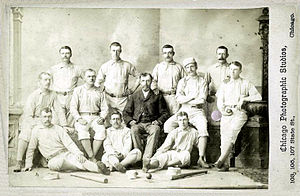
1882 Providence Grays
The Providence Grays were a Major League Baseball franchise based in Providence, Rhode Island from 1878 to 1885. During the team's eight seasons in the National League (NL), which then comprised eight teams, they finished third place or higher in the final standings seven times, and won the league championship in both 1879 and 1884. Providence played their home games at the Messer Street Grounds, which was located in the Olneyville neighborhood of Providence. The Grays were officially organized on January 16, 1878 by Benjamin Douglas, who became the team's general manager. Henry Root was hired as the team president‚ and Tom Carey was initially hired to be the on-field captain, whose duties were similar to the modern-day manager. On January 21, 1878, Providence applied for membership in the NL, and was officially approved on February 6. On April 10, Root took over ownership of the team, fired Douglas for incompetence and insubordination, and hired Tom York to replace Carey as captain.
Providence was successful in signing several star players for their inaugural season: Paul Hines had played the previous four seasons with the Chicago White Stockings; Tom Carey was signed after the Hartford Dark Blues folded; Doug Allison was the catcher for the 1869 Cincinnati Red Stockings, who had an 84-game winning streak from 1869 to 1870; and John Montgomery Ward, who was playing his first season in the major leagues. Ward had a win–loss record of 22–13 and Hines led the league in home runs, runs batted in (RBIs), and batting average as the Grays finished in third place among the six teams in the NL for the 1878 season, with a record of 33 wins, 27 losses, and 2 ties. The Grays won the NL championship in 1879, placing first among the league's eight teams with Ward winning 47 games as their starting pitcher, and the leadership of George Wright, who played second base and also managed. The team had a strong hitting line-up with Hines' league leading .357 batting average, as well as new additions Jim O'Rourke and Joe Start, who both had batting averages over .300. William Edward White, a Brown University player who played one game for the Grays on June 21, 1879, may have been the first African-American to play at the major league level; according to Peter Morris of the Society for American Baseball Research, the evidence for White is strong, but not conclusive. If this claim is true, then White pre-dated both Moses Fleetwood Walker and his brother Weldy Walker, who both played for the 1884 Toledo Blue Stockings of the American Association (AA). In 1880, the Grays finished in second place among the eight NL teams, with Ward winning 39 games. On June 17 of that year, Ward pitched the second perfect game in major league history. (Full article...) -
Image 7

Keith Hernandez won eleven consecutive Gold Gloves at first base, the most by any MLB player.
The Gold Glove Award is the award given annually to the Major League Baseball players judged to have exhibited superior individual fielding performances at each fielding position in both the National League (NL) and the American League (AL), as voted by the managers and coaches in each league. Managers are not permitted to vote for their own players. Eighteen Gold Gloves are awarded each year (with the exception of 1957, 1985, 2007 and 2018), one at each of the nine positions in each league. In 1957, the baseball glove manufacturer Rawlings created the Gold Glove Award to commemorate the best fielding performance at each position. The award was created from a glove made from gold lamé-tanned leather and affixed to a walnut base. Initially, only one Gold Glove per position was awarded to the top fielder at each position in the entire league; however, separate awards were given for the National and American Leagues beginning in 1958.
Keith Hernandez has won the most Gold Gloves at first base, capturing 11 consecutive awards in the National League from 1978 to 1988. In the American League, Don Mattingly won nine times with the New York Yankees for the second-highest total among first basemen, and George Scott won eight awards playing for the Boston Red Sox (three) and the Milwaukee Brewers[a] (five). Vic Power[b], and Bill White each won seven awards; six-time winners include Wes Parker and J. T. Snow. Mark Teixeira has won five Gold Gloves at the position. Gil Hodges, Eddie Murray and Jeff Bagwell are the only members of the Baseball Hall of Fame to have won a Gold Glove at first base. (Full article...) -
Image 8

In baseball, a strikeout occurs when a pitcher throws three strikes to a batter during his time at bat. Under Rules 6.05 and 6.09 of the Official Rules of Major League Baseball, a batter becomes a runner when a third strike is not caught by the catcher with no runner on first base or when there are two outs. The strikeout is recorded, but the batter-runner must be tagged or forced out in order for the defensive team to register the out. Thus, it is possible for a pitcher to record more than three strikeouts in an inning.
As a result of this rule, 93 different pitchers have struck out four batters in a half-inning of a Major League Baseball (MLB) game, the most recent being Tyler Glasnow of the Tampa Bay Rays on July 7, 2023. Five players – Chuck Finley, A. J. Burnett, Zack Greinke, Craig Kimbrel, and Tyler Glasnow – have accomplished the feat more than once in their career (Finley is the only one to do it three times, and all three times were within a one-year span); no player has ever struck out more than four batters in an inning. Ed Crane was the first player to strike out four batters in one inning, doing so in the fifth inning for the New York Giants against the Chicago White Stockings on October 4, 1888. (Full article...) -
Image 9

Alex Cora (waving) is the most recent manager to lead the Red Sox to a World Series championship.
The Boston Red Sox are a professional baseball team based in Boston, Massachusetts. The Red Sox are members of the American League (AL) East Division in Major League Baseball (MLB). They have competed since 1901, initially as the Boston Americans (1901–1907), and under their current name since 1908. Since 1912, the Red Sox have played their home games at Fenway Park. In baseball, the head coach of a team is called the manager, or more formally, the field manager. There have been 48 different managers in franchise history; the current manager is Alex Cora, who previously managed the team during the 2018 and 2019 seasons and was re-hired by the team on November 6, 2020.
Jimmy Collins was the first manager of the franchise, managing from 1901 to 1906. Among all Red Sox managers, Joe Cronin managed the most regular season games (2,007) and registered the most regular season wins (1,071), while Terry Francona managed the most playoff games (45) and registered the most playoff wins (28). The most World Series championships won by a Red Sox manager is two, accomplished by Bill Carrigan (1915 and 1916) and Francona (2004 and 2007). John McNamara and Jimy Williams are the only two Red Sox managers to win the AL Manager of the Year Award, in 1986 and 1999, respectively. (Full article...) -
Image 10Lou Piniella won the 2008 National League Manager of the Year Award, and won twice in the American League.
In Major League Baseball, the Manager of the Year Award is an honor given annually since 1983 to two outstanding managers, one each in the American League (AL) and the National League (NL). The winner is voted on by 30 members of the Baseball Writers' Association of America (BBWAA). Each submits a vote for first, second, and third place among the managers of each league.[a] The manager with the highest score in each league wins the award.
Several managers have won the award in a season in which they led their team to 100 or more wins. They are:- Lou Piniella – 116 (Seattle Mariners, 2001)
- Joe Torre – 114 (New York Yankees, 1998)
- Gabe Kapler – 107 (San Francisco Giants, 2021)
- Sparky Anderson – 104 (Detroit Tigers, 1984)
- Tony La Russa – 104 (Oakland Athletics, 1988)
- Dusty Baker – 103 (San Francisco Giants, 1993)
- Larry Dierker – 102 (Houston Astros, 1998)
- Whitey Herzog – 101 (St. Louis Cardinals, 1985)
- Rocco Baldelli – 101 (Minnesota Twins, 2019)
- Buck Showalter – 101 (New York Mets, 2022)
- Brandon Hyde – 101 (Baltimore Orioles, 2023)
- Kevin Cash – 100 (Tampa Bay Rays, 2021)
-
Image 11The Hutch Award is given annually to an active Major League Baseball (MLB) player who "best exemplifies the fighting spirit and competitive desire" of Fred Hutchinson, by persevering through adversity. The award was created in 1965 in honor of Hutchinson, the former MLB pitcher and manager, who died of lung cancer the previous year. The Hutch Award was created by Hutch's longtime friends Bob Prince, a broadcaster for the Pittsburgh Pirates and KDKA; Jim Enright, a Chicago sportswriter; and Ritter Collett, the sports editor of the Dayton Journal Herald. They also created a scholarship fund for medical students engaged in cancer research to honor Hutchinson's memory.
Eleven members of the National Baseball Hall of Fame have won the Hutch Award. The inaugural winner was Mickey Mantle. Danny Thompson, the 1974 recipient, was diagnosed with leukemia earlier that year. He continued to play through the 1976 season before dying that December at the age of 29. Jon Lester won the award in 2008 after recovering from anaplastic large-cell lymphoma. (Full article...) -
Image 12

Mike Piazza is the all-time leader in Silver Slugger Awards among catchers, winning ten consecutive from 1993 to 2002.
The Silver Slugger Award is awarded annually to the best offensive player at each position in both the American League (AL) and the National League (NL), as determined by the coaches and managers of Major League Baseball (MLB). These voters consider several offensive categories in selecting the winners, including batting average, slugging percentage, and on-base percentage (OBP), in addition to "coaches' and managers' general impressions of a player's overall offensive value." Managers and coaches are not permitted to vote for players on their own team. The Silver Slugger was first awarded in 1980 and is given by Hillerich & Bradsby, the manufacturer of Louisville Slugger bats. The award is a bat-shaped trophy, 3feet (91cm) tall, engraved with the names of each of the winners from the league and plated with sterling silver.
Among catchers, Mike Piazza has won the most Silver Slugger Awards, with ten consecutive wins in the National League between 1993 and 2002; this is the most Silver Sluggers won consecutively by any player in Major League Baseball. In the American League, Iván Rodríguez has won the most Silver Sluggers, with six consecutive wins from 1994 to 1999, and a seventh when he tied with Víctor Martínez in 2004. Lance Parrish won the American League award six times (1980, 1982–1984, 1986, and 1990), and Joe Mauer, Jorge Posada and Salvador Pérez have won it five times; Mauer won in 2006, 2008–2010 and 2013, Posada won in 2000–2003 and 2007, and Pérez won it in 2016, 2018, 2020, 2021 and 2024. Hall of Famer Gary Carter (1981–1983, 1984–1986), Buster Posey (2012, 2014–2015, 2017, 2021), and Brian McCann (2006, 2008–2011) are five-time winners in the National League; McCann also won a sixth Silver Slugger in 2016, but in the American League. Other multiple awardees include Benito Santiago (four wins; 1987–1988, 1990–1991), J. T. Realmuto (three wins; 2018–2019, 2022), Mickey Tettleton (three wins; 1989, 1991–1992) and Carlton Fisk (three wins; 1981, 1985, 1988). William Contreras and Salvador Pérez are the most recent National and American League winners, respectively. (Full article...) -
Image 13

In Major League Baseball (MLB), the 20–20–20 club is the group of batters who have collected 20 doubles, 20 triples and 20 home runs in a single season. Frank Schulte was the first to achieve this, doing so in 1911. The last players to reach the milestone – Curtis Granderson and Jimmy Rollins – attained 20–20–20 during the 2007 season. This marked the first time that two players accomplished the achievement in the same season.
In total, seven players are members of the 20–20–20 club. Of these, five were left-handed batters, one was right-handed and one was a switch hitter, meaning he could bat from either side of the plate. Two players – George Brett and Willie Mays – are also members of the 3,000 hit club, and Mays is also a member of the 500 home run club. Schulte, Rollins, and Jim Bottomley won the Most Valuable Player (MVP) Award in the same year as their 20–20–20 season. Both Mays and Rollins joined the club while also hitting 30 home runs and stealing 30 bases that same season to join the 30–30 club. Brett and Rollins collected more than 200 hits alongside achieving 20–20–20. Furthermore, four players amassed 20 or more stolen bases during their 20–20–20 season. These players are collectively referred to as the 20–20–20–20 club. (Full article...) -
Image 14

Manager Fran Riordan looks on as Melvin Mercedes slides into third base.
The Nashville Sounds Minor League Baseball team has played in Nashville, Tennessee, since being established in 1978 as an expansion team of the Double-A Southern League. They moved up to Triple-A in 1985 as members of the American Association before joining the Pacific Coast League in 1998. With the restructuring of the minor leagues in 2021, they were placed in the Triple-A East, which became the International League in 2022. The team has been led by 29 managers throughout its history. Managers are responsible for team strategy and leadership on and off the field, including determining the batting order, arranging defensive positioning, and making tactical decisions regarding pitching changes, pinch-hitting, pinch-running, and defensive replacements. Rick Sweet has been the Sounds' manager since 2021.
As of the completion of the 2024 season, Nashville's managers have led the club for 6,566 regular-season games in which they have compiled a win–loss record of 3,398–3,168–2 (.518). In 16 postseason appearances, their teams have a record of 49–44 (.527) and have won two Southern League championships and one Pacific Coast League championship. Combining all 6,659 regular-season and postseason games, the Sounds have an all-time record of 3,447–3,212–2 (.523). (Full article...) -
Image 15
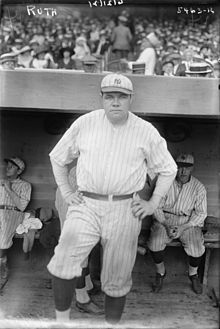
Babe Ruth holds sixteen franchise, four American League, and two Major League records.
The New York Yankees are a professional baseball team based in the Bronx, New York. They compete in the East Division of Major League Baseball's (MLB) American League (AL). The club began play in 1903 as the Highlanders, after owners Frank Farrell and William S. Devery had bought the defunct Baltimore Orioles and moved the team to New York City; in 1913, the team changed its nickname to the Yankees. From 1903 to 2023, the franchise has won more than 10,000 games and 27 World Series championships. The list below documents players and teams that hold particular club records.
Outfielder Babe Ruth holds the most franchise records, with 16, including career home runs, and career and single-season batting average and on-base percentage. Shortstop Derek Jeter has the second-most records among hitters, with eight. Jeter's marks include the records for career hits, singles, doubles, and stolen bases. Among pitchers, Whitey Ford has the most Yankees records with five, all of which are career totals. These include games won, games started, and innings pitched. (Full article...)
More did you know
- ... that Yoennis Céspedes was described by Baseball Prospectus as "arguably the best all-around [baseball] player to come out of Cuba in a generation"?
- ... that baseball outfielder Adam Eaton received USD $120,000 meant for the retired pitcher of the same name?
- ... that professional baseball player Bill Bagwell led three different leagues in batting average?
- ... that four men involved in the 1877 Louisville Grays scandal were banned from professional baseball for life?
- ... that Josh Bell received a US$5 million signing bonus, a record for a player chosen in the second round of the Major League Baseball Draft?
Sports portals
Selected picture
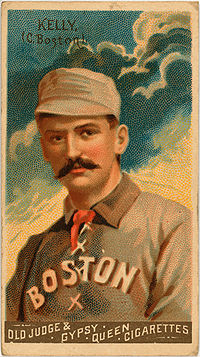
| Credit: Benjamin K. Edwards Collection |
Michael Joseph "King" Kelly (December 31, 1857 – November 8, 1894) was an American right fielder, catcher, and manager in various professional American baseball leagues including the National League, International Association, Players' League, and the American Association.
Associated Wikimedia
The following Wikimedia Foundation sister projects provide more on this subject:
-
Commons
Free media repository -
Wikibooks
Free textbooks and manuals -
Wikidata
Free knowledge base -
Wikinews
Free-content news -
Wikiquote
Collection of quotations -
Wikisource
Free-content library -
Wikiversity
Free learning tools -
Wiktionary
Dictionary and thesaurus
More portals
- Portals with triaged subpages from June 2018
- All portals with triaged subpages
- Portals with no named maintainer
- Automated article-slideshow portals with 51–100 articles in article list
- Automated article-slideshow portals with 501–1000 articles in article list
- Random portal component with 41–50 available subpages
- Automated article-slideshow portals with 201–500 articles in article list
- Random portal component with 11–15 available subpages
- Random portal component with 21–25 available image subpages



